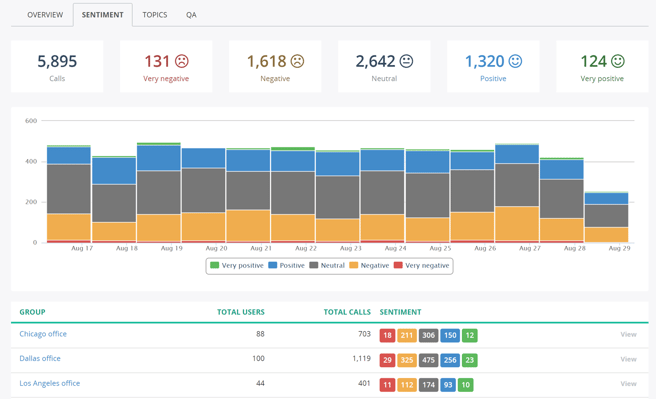8 Contact Center-Generated Customer Insights Your Marketing & Sales Team Needs
Do you know what your customers are saying about you? Do they feel like you are providing the best possible customer experience you can? Or are your customers about to jump ship to a competitor or tell their friends and family about a bad experience they had with your company?
Because these things matter — greatly! For example,
- 86% of buyers are willing to pay more for a great customer experience,
- 79% of customers have switched companies due to poor customer service, and
- The average American will tell 15 people about a bad customer service experience, but only 11 about a good one.
What do these statistics mean for your business? They underscore the importance of providing an excellent customer experience. And one of the best ways to ensure that you're providing an excellent customer experience is by truly understanding what your customers think and feel about you.
Contact centers have thousands of customer interactions and therefore generate a lot of customer insight data which is extremely useful to internal marketing and sales organizations. This data can provide valuable feedback about customer perceptions, preferences, and purchasing behavior.
You can use it to measure the effectiveness of a recent marketing campaign, gauge price sensitivity, glean competitive intelligence, quickly identify customer pain points and areas for improvement, and much more.
In this blog post, we will discuss eight contact center-generated customer insights that are essential for marketing and sales teams.

1) Monitor Pricing Feedback & Gauge Price Sensitivity
If you're considering a price change (especially price increases) for your product or service, customer feedback from your contact center can be extremely helpful. With AI-driven Voice Analytics, you can automatically extract keywords and phrases like "too expensive", "not worth the money", "very costly" and others to monitor customer sentiment around pricing and identify any potential concerns.
You can also use it to learn more about your customers' price sensitivity. How do customers react to different pricing models? Are they willing to pay more for certain features? This information can help you make decisions about pricing changes and ensure that any increases are well-received by your customer base.
2) Monitor Customer Sentiment Around Your Brand

Screenshot of MiaRec Sentiment Analysis Dashboard
Voice Analytics can also be used to monitor customer sentiment around your brand. Simply look for your brand name as well as the names of your product/services and cross-analyze this data with the customer sentiment over time. Is brand sentiment improving or deteriorating? Have you recently run a larger brand awareness campaign?
This is valuable intelligence that can help you make necessary changes to improve customer satisfaction. By understanding how your customers feel about your brand, you can make the necessary changes to ensure that they continue to be happy and loyal customers.
3) Glean Competitive Intelligence
If you're looking for insights into what your competitors are doing, contact center customer data can be extremely helpful. Just as you would when looking for your own brand name, you can use Voice Analytics to automatically extract mentions of competitor names and products. This information can be used to track customer loyalty, product preference, and more.
Additionally, this data can help you understand how your own marketing and sales efforts compare to your competitors' efforts. Are you losing customers to a competitor? Why? What are they doing that you're not? This type of competitive intelligence is essential for making sure that you stay ahead of the competition.
4) Increase Sales Conversions

Screenshot of MiaRec Voice Analytics Tab featuring Topical and Keyword Analysis
Sales conversions are essential for any business. In order to increase sales conversions, you need to make sure that your agents have a good understanding of your product/service properly, are adequately trained, and have prescribed ways to handle difficult situations. That is why it is important to construct a call script that is customer-centric and relevant for up-sells and cross-sells.
You can achieve this by using Voice Analytics to identify successful and unsuccessful calls to understand what determined the outcome (e.g., Was it a certain call-handling technique that made the difference?) For more tips on how to use call recording and Voice Analytics, please refer to this blog post.
5) Track The Effectiveness Of Recent Promotional Activity Or New Marketing Campaigns
You can also use Voice Analytics to track customer sentiment around a recent promotional activity or new marketing campaign. By tracking the number of calls that mention the promotional activities or marketing campaigns and cross-referencing them with the customer sentiment, you can — immediately after launch — gauge the effectiveness of the campaign.
This allows you to make necessary changes early on, saving you money in the process. For example, if you see a decrease in customer satisfaction after a new marketing campaign, you can quickly identify the problem and make changes to improve the situation.
6) Monitor Customer Feedback After New Product Introduction

If you're introducing a new product or service, it's important to monitor customer feedback to ensure that they're happy with the changes. With AI-driven Voice Analytics, you can automatically extract keywords and phrases to monitor customer sentiment around the new product/service. This information can help you make decisions about pricing, positioning, and promotions for the new product/service.
Moreover, this data can help you understand how your customers feel about your brand and whether or not they are loyal customers. If you see a decrease in customer satisfaction, you can quickly identify the problem and make changes to improve the situation. This is an essential part of ensuring customer loyalty and retaining them as long-term customers.
7) Monitor Customer Sentiment As An Indicator Of Customer Loyalty
How do customers feel about your product or service? Are they satisfied or unhappy? Positive sentiment can be a powerful indicator of customer loyalty and customer lifetime value. With AI-driven Voice Analytics, you can automatically extract customer sentiment data from customer interactions.
These insights can be used to improve customer satisfaction by making changes to your product or service. In addition, this data can help you identify loyal customers and understand why they are loyal. If you see a decrease in customer satisfaction, you can quickly identify the problem and make changes to improve the situation.
8) Track Regulatory Compliance
Contact centers often have to implement new regulation language or updated disclosures within workflows, sales, or product sales. This is especially true for financial institutions and healthcare providers. Using Voice Analytics, you can monitor for exact compliance by listening not only for the exact wording that has to be said by the agent, but also for the reaction of the customers to this. If this new process causes a negative reaction, is there another way you could manage those new regulations or disclosure notices?
Conclusion
Contact centers generate a lot of customer insight data that is extremely useful to internal marketing and sales organizations. You can use AI-driven Voice Analytics (like MiaRec offers) to not only analyze what your customers are saying, but also measure the effectiveness of a recent marketing campaign, gauge price sensitivity, glean competitive intelligence, identify loyal customers and understand why they are loyal, and much more.
So if you haven't already started using Voice Analytics in your contact center, now is the time to do so! Your customers' voices hold valuable insights, and by using those insights wisely, you can take your marketing and sales efforts to the next level. All you need is the right tool to uncover them.
You May Also Like
These Related Stories
.png?width=1129&height=627&name=Untitled%20design%20(37).png)
Why You Should Start Tagging Every Contact Center Call Now
.png)
Conversation Intelligence vs. Voice Analytics And More: What Is Best For You?


